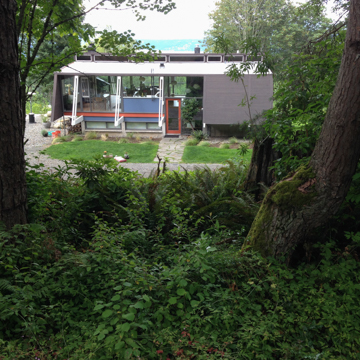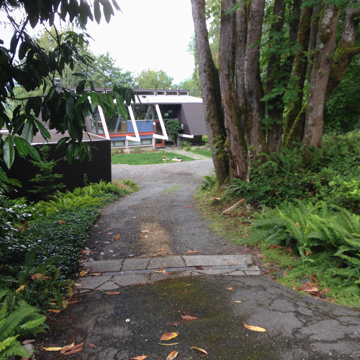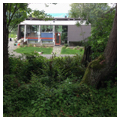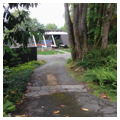Wendell H. Lovett designed a relatively late and highly idiosyncratic house at the Hilltop Community for Gervais and Connie Reed in 1954–1955. This house retains much of its original integrity, and has, from 1955 onward, been one of Hilltop’s most exceptional residences, both for Lovett’s architectural design and his custom interior furnishings. Similar to much of Lovett’s earliest work, which was strongly influenced by Mies van der Rohe’s Edith Farnsworth House in Plano, Illinois, the Reed House was a rectangular prism. Unlike his earlier work, however, this house explored new exterior forms and more enclosed spaces inside, suggesting new directions for the architect.
Lovett devised a two-story, split-level arrangement. Both Gervais Reed and Lovett taught at the University of Washington at this time: Lovett in the School of Architecture, and Reed in the Art Department. For the Reeds, Lovett provided much taller window proportions on the upper floor than the lower, located most of the key spaces on the upper floor, and positioned the entry halfway between the floors. The house’s footprint was roughly square, approximately 40 by 40 feet. Its windows faced northeast and southwest—the former featuring more expansive views. The upper floor had two bedrooms located on its east end with an entry/storage section to its west, near the plan’s center. To the west of the entry, Lovett included a compact, U-shaped kitchen and an adjoining dining space. On the first floor’s northern half, he positioned the living room to take in the remarkable views looking northeast. Connected to the living room, a small elevated deck invited inhabitants outside for even better vantage points.
Seen from the exterior, the house had an unusual gambrel-shaped roof that does not meet precisely at the peak. Rather, the north-facing half stood taller, creating space for a clerestory at the peak. As T. William Booth and Grant Hildebrand have observed, Lovett’s use of a gambrel versus a flat roof enabled “…diagonal elements in section and elevation [to] provide both lateral rigidity and a richer sculptural profile.” On the interior, exposed bowed roof beams supported the roof; in cross-section, these beams, assembled by Walter Isaacs (also a faculty member in the University of Washington Art Department), resembled airfoils. (Lovett had a lifelong fascination with airplanes.) The interior beams connected with pairs of angled posts on the exterior, which, in turn, formed a bypass connection with projecting first-floor joists.
Lovett’s remarkable interior furnishings designed for the house derived from various sources. His wood-frame cabinets, seen in the kitchen, suggested the Eames Storage Units produced by Herman Miller. The folded sheet steel firehood had a bold sculptural presence comparable to Italian models the architect saw in Domus magazine, which he avidly read from the late 1940s on. Lovett also created a built-in sofa, with curving wings that echoed the biomorphic work done by Finn Juhl in Denmark.
The Reeds resided in the house from 1955 until 2012. Many of the interior furnishings were removed when Connie Reed moved out of the house in 2012. The interior was renovated for new owners Patrick and Courtney Stanton by Schemata Workshop in 2013.




